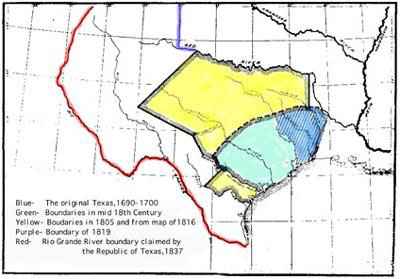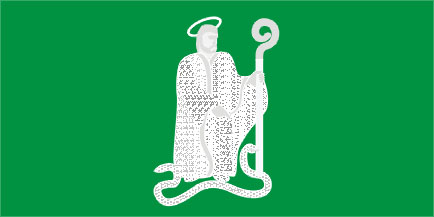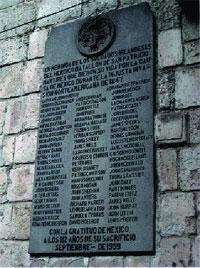Irish
‘Patricios’ in Texas and Mexico
By Roy Cook
At this time of significant
attention in Rome and the annual St Patrick’s Day with its green
beer and everyone is Irish attitude is a good time to look deeper into
that historic time in USA and Mexico history. Those political actions
impacted many, many Southwestern Tribal Native American Nations. The war
between the United States and Mexico had several basic causes.
 1.
Not all American westward migration was unwelcome. In the 1820's and 1830's,
Mexico, newly independent from Spain, needed settlers in the under-populated
northern parts of the country. An invitation was issued for people who
would take an oath of allegiance to Mexico and convert to Catholicism,
the official religion. Thousands of Americans took up the offer and moved,
often with slaves, to the Mexican province of Tejas (Texas). Soon however,
many of the new "Texicans" or "Texians" were unhappy
with the way the government in Mexico City tried to run the province.
In 1835, the Tejanos revolted, and after several bloody battles, the Mexican
President, Santa Anna, was forced to sign the Treaty of Velasco in 1836
This treaty gave Tejas (Texas) its independence, but many Mexicans refused
to accept the legality of this document, as Santa Anna was a prisoner
of the Tejanos at the time.
1.
Not all American westward migration was unwelcome. In the 1820's and 1830's,
Mexico, newly independent from Spain, needed settlers in the under-populated
northern parts of the country. An invitation was issued for people who
would take an oath of allegiance to Mexico and convert to Catholicism,
the official religion. Thousands of Americans took up the offer and moved,
often with slaves, to the Mexican province of Tejas (Texas). Soon however,
many of the new "Texicans" or "Texians" were unhappy
with the way the government in Mexico City tried to run the province.
In 1835, the Tejanos revolted, and after several bloody battles, the Mexican
President, Santa Anna, was forced to sign the Treaty of Velasco in 1836
This treaty gave Tejas (Texas) its independence, but many Mexicans refused
to accept the legality of this document, as Santa Anna was a prisoner
of the Tejanos at the time.
2. This action added
to the desire of the U.S. to expand across the North American continent
under the policy of Manifest Destiny. This aggressive policy sought to
expand the domination and colonial policy to the Pacific Ocean. Regardless
that this un-constitutional action caused conflict with all of the U.S.
neighbors; from the British in Canada and Oregon to the Mexicans in the
southwest and, of course, with the Native Americans, many on U.S. Treaty
secured lands and all with aboriginal land title.
3. The next basic
cause of the war with Mexico was the Texas War of Independence and the
subsequent annexation of that area to the United States. History supports
the fact that many wealthy Easterners bought their way out of the army
and the poor immigrants given US citizenship had little choice but to
fight even in the civil war. Irish-born members represented nearly 50
per cent of the US military.
One interesting aspect
of the war involves the fate of U.S. Army deserters of Irish origin who
joined the Mexican Army as the Battalion San Patricio (Saint Patrick's
Battalion). This group of Catholic Irish immigrants rebelled at the abusive
treatment by Protestant, American-born officers and at the treatment of
the Catholic Mexican population by the U.S. Army. At this time in American
history, Catholics were an ill-treated minority, and the Irish were an
unwanted ethnic group in the United States.
 Many
Historians depending on their personal religious view do not touch upon
the fact that the US army in the South was very anti-catholic. The KKK
was strong and the NINA (No Irish Need Apply) signs were still hanging
in storefronts. However there were Irish troops in both the South and
the North.
Many
Historians depending on their personal religious view do not touch upon
the fact that the US army in the South was very anti-catholic. The KKK
was strong and the NINA (No Irish Need Apply) signs were still hanging
in storefronts. However there were Irish troops in both the South and
the North.
The Irish Immigrants
after seeing the destruction and rape of Mexican Catholics and small catholic
villages gave their loyalty to Mexico especially after suffering anti-Catholic
and anti-Irish from their native Ireland and abuse from their US officers
in the American army prior to the civil war. They were considered Mexican
citizens
renowned for their bravery in the face of certain defeat and were also
given land, as were many immigrants in the US. Mexico was mainly a Catholic
Country.
The story of this
famed group begins with the founder and chief conspirator, John Riley,
a Galway native born in 1817. Riley deserted from the British army while
stationed in Canada and went to Michigan, where he later enlisted in the
US Army in 1845. He was able to defect to the Mexican Army when his commander
granted him permission to cross into Mexico to attend mass. It was there,
in Matamoros, Riley joined the Mexican Army as a lieutenant, which resulted
in his pay rising from seven dollars per month to 57 dollars per month.
While desertion from the US armed forces was punishable by death. Even
when the number of San Patricios rose to more than 200. In September 1847,
the U.S. Army hanged sixteen surviving members of the San Patricios as
traitors. To this day, they are considered heroes in Mexico.
Looking back, to the motivation for the policy of Manifest Destiny, we
need to examine President Jefferson's acquisition of the right to treat
with the original holders of the land by residence and treat only! All
the Indian Nations land was still held under aboriginal land title and
the Constitution of the United States does not allow grabbing land outside
the law.
Americans illegally migrated westward in ever increasing numbers, very
often into lands not belonging to the United States. By the time President
Polk came to office in 1845, this idea, based on Euro-based racist principals
called "Manifest Destiny", had taken root among the American
people, and President Polk was a firm believer in the idea of expansion.
The belief that the U.S. basically had a Euro-centered God-given right
to occupy and "civilize" the whole continent gained favor as
more and more Americans invaded the western lands. The fact that most
of those areas already had Tribal people living upon them was usually
ignored, with the attitude that English-speaking America, with its high
ideals and Protestant Christian ethics, would do a better job of running
things than the Native Americans or Spanish-speaking Catholic Mexicans.
Manifest Destiny
did not necessarily call for violent expansion if the land can be bought
cheap. In both 1835 and 1845, the United States offered to purchase California
from Mexico, for $5 million and $25 million, respectively. The Mexican
government refused the opportunity to sell half of its country to Mexico's
most dangerous neighbor. Many Americans opposed what they called "Mister
Polk's War." Whig Party members and abolitionists in the North believed
that slave-owners and Southerners in Polk's administration had planned
the war. They believed the South wanted to win Mexican territory for the
purpose of spreading and strengthening slavery. This opposition troubled
President Polk. But he did not think the war would last long. He thought
the US could quickly force Mexico to sell him the territory he wanted.
Polk secretly sent a representative to former Mexican dictator Santa Ana,
who was living in exile in Cuba. Polk's representative said the United
States wanted to buy California and some other Mexican territory. Santa
Ana said he would agree to the sale, if the United States would help him
return to power. President Polk ordered the US Navy to let Santa Ana return
to Mexico. American ships that blocked the port of Vera Cruz permitted
the Mexican dictator to land there. Once Santa Ana returned, he failed
to honor his promises to Polk. He refused to end the war and sell California.
Instead, Santa Ana organized an army to fight the United States. After
the beginning of hostilities, the U.S. military reported to the President
and it became apparent to the Polk Administration that only a complete
battlefield victory would end the war. Continued fighting in the dry deserts
of northern Mexico convinced the United States that an overland expedition
to capture of the enemy capital, Mexico City, would be hazardous and difficult.
To this end, General Winfield Scott proposed what would become the largest
amphibious landing in history, (at that time), and a campaign to seize
the capital of Mexico. The Marine Corps still recognizes this landing
in the first line of the Corps’ hymn: From the Halls of Montezuma.
 Most
tragically, as a result of the savage frontier fighting, the American
public developed a very negative stereotype against the Mexican people
and government. Partly due to the continued hostilities with Mexico, Texas
decided to join with the United States, and on July 4, 1845, the annexation
gained approval from the U.S. Congress.
Most
tragically, as a result of the savage frontier fighting, the American
public developed a very negative stereotype against the Mexican people
and government. Partly due to the continued hostilities with Mexico, Texas
decided to join with the United States, and on July 4, 1845, the annexation
gained approval from the U.S. Congress.
The Mexican government
dedicated a commemorative plaque to the San Patricios across from San
Jacinto Plaza in the Mexico City suburb of San Angel; it lists the names
of all members of the battalion who lost their lives fighting for Mexico,
either in battle or by execution.
Remember: Erin go Bragh' - Ireland forever.